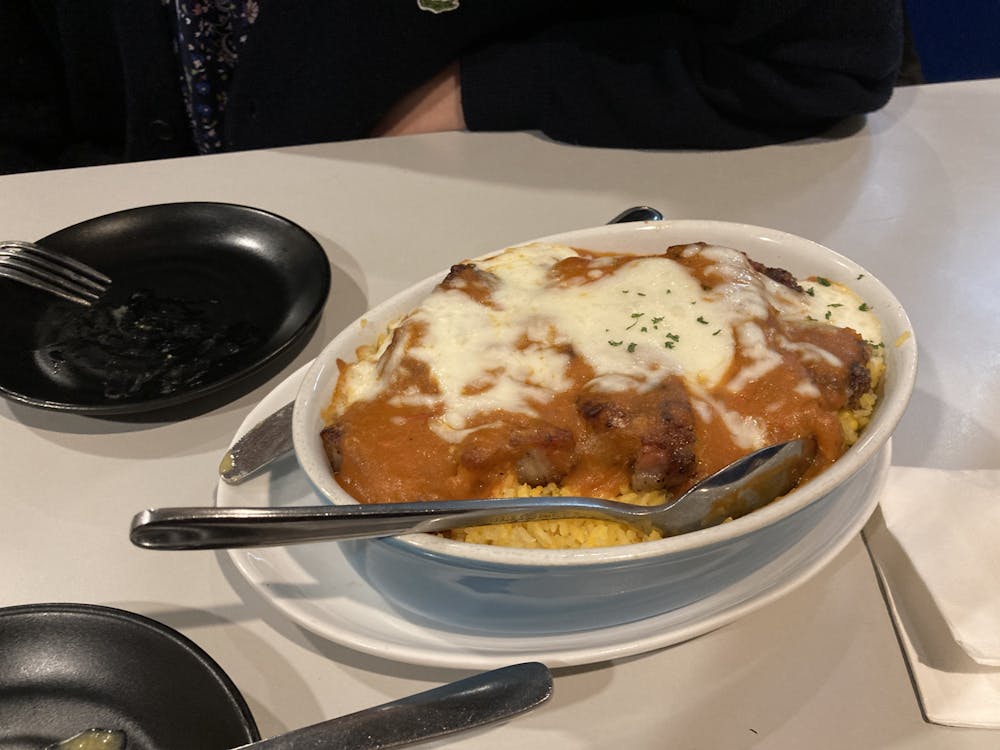
My sister always does the deep frying.
Unafraid of the hot oil, she lays two egg-and-flour-covered pork chops into the wok. They sizzle and solidify into crunchy golden pucks after which she stacks them on paper towels to allow the excess oil to drain.
I am in charge of everything else: chopping tomatoes and onions, cooking the sauce, stir-frying the rice in egg and arranging everything into their organized layers in the baking dish.
My first time cooking baked pork chop rice (guk ju paa fan in Cantonese), I used too much pork and not enough rice. Not only that, but the pork ended up tough and stringy, a result of my decision to prioritize cheapness when choosing the cut of meat. Still, my parents and sister ate it without complaint.
Before this, I’d only ever had the dish in restaurants, where it’s usually served in an oblong metal tray with some drink — Ovaltine, Horlicks, tea — on the side. In Houston, the only restaurants that served baked pork chop rice and other foods from Hong Kong cuisine were at least a thirty-minute drive from my house. The drive became second nature, though — a necessary commute for my family to access authentic Asian restaurants and grocery stores in Chinatown.
Making the dish at home, it was easy to compare my attempts to the restaurant quality examples I’d had in the past. I was most critical about pleasing my mom, who was born in Hong Kong and grew up eating baked pork chop rice. Leaving her home in her twenties to study film in the U.S., my mom talks about missing these comforting dishes and Hong Kong in general. However, whenever I ask her if she would ever return, she always says no.
“It’s been so long,” she says, “I no longer know Hong Kong.”
When she says this, I understand that she’s referring to something more than just the usual transformation that any city goes through over time. Hong Kong has experienced specific political changes as a result of shifting global power dynamics.
From 1842 to 1997, Hong Kong was a British colony. After the handover of Hong Kong in 1997, the official event returning Hong Kong to China, many citizens found themselves fearful of the changes that would come with Communist rule. Rights that they had enjoyed under Britain, like freedoms of speech and press, would be threatened by the Chinese government’s influence.
After returning to being under Chinese authority, Hong Kong has experienced some of the changes people feared. The enactment of extradition laws and new policies related to registering for election candidacy has resulted in large protests and social movements such as the Umbrella Movement. More than 100,000 people have fled the city to other countries, like the U.S., the U.K. and Canada, in recent years.
In recent years, the United Kingdom enacted a settlement scheme using the British National (Overseas) passports given to Hong Kong citizens before the handover, which would allow them to move to the U.K. and eventually become eligible for settled status. Created in response to recent controversial laws enforced by China on Hong Kong, the scheme has resulted in another wave of emigration from the city and one that pushed some of my very own relatives to relocate to the United Kingdom.
Across the sea, my family and I are not as directly affected by these changes, but my parents can still feel a distinct sense of loss: Hong Kong is changing rapidly and losing itself in the process. Knowing that the city she visits will be very different from the city she knows, my mother still tries to find comfort in familiar dishes, music and customs.
For my mother’s birthday last year, in lieu of a birthday present, my mother asked me to cook this dish for her. It isn’t her favorite dish — that would be sweet and sour pork, or gu lou yuhk — but it is still a dish that reminds her of home.
Baked pork chop rice is like Hong Kong, a mix of East and West and yet distinctively its own.
After 100 years of British imperial rule, cultural syncretism has resulted in unique gastronomic and linguistic qualities in Hong Kong. Many schools and court proceedings in the city are still led entirely in English. Some of Hong Kong’s most famous recipes are part of a cuisine known outside of the city as gong sik sai chaan — literally, Canto-Western cuisine — featuring Western-influenced dishes like egg tarts, HK-style French toast, Swiss sauce chicken wings and, of course, baked pork chop rice.
Each ingredient within baked pork chop rice can be tied to either the East or the West. Egg fried rice is undoubtedly Eastern. Cheese is Western. The pork is marinated in Chinese marinades and sauces. Ketchup, a Western import, is used in the tomato sauce.
Only 30 years ago, Hong Kong was still a British colony. In fact, the city only went back to China after my parents had already left for college in the United States. I’ve asked my parents many times how it felt to grow up in a colony, and I’m always surprised to hear them discuss that, despite the distinct feeling of otherness that comes with living under imperial rule, they are proud of the unique identity that the city has developed.
Hong Kong is not China, nor is it Britain. It is only Hong Kong.
Aliza Li is a junior from Houston, Texas studying Writing Seminars. She is the Voices Editor for The News-Letter. Her column discusses her journey as a writer and how words have transformed her life.





